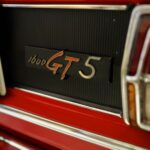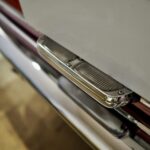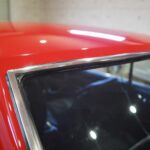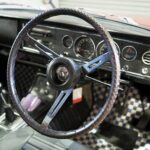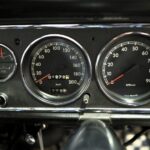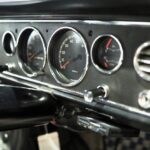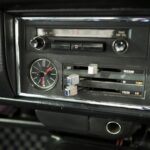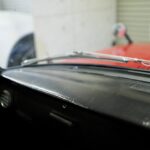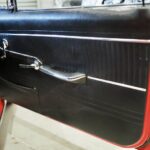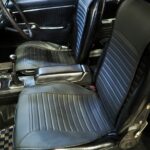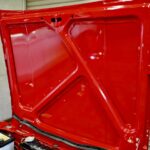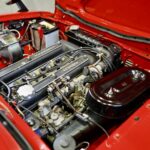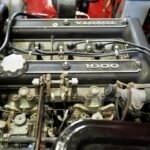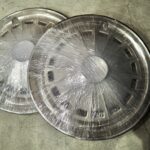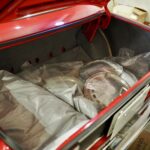TOP>Stock List>1967model Toyota 1600 GT5
1967model
Toyota 1600 GT5
↑↑↑Please watch the archived video above with audio if possible...
"Making dreams from those days a reality... The Toyota 1600 GT5, a sibling of the legendary Toyota 2000GT that captured the hearts of young people back then, has survived in the hands of a collector in pristine condition, showing just 19,782 km on the odometer...! This incredibly rare early model RT55-11568, featuring highly valuable dead stock parts (!!!) without any hesitation, is in astonishing condition. It remains fully original, has undergone a meticulous restoration, and impresses all who see it in its perfect state, having just passed its inspection...!"
n a fully shuttered, climate-controlled garage, the Solar Red Toyota 1600 GT5 stands silently, showing no signs of the half-century or more that has passed… This fully original vehicle, preserving its appearance from back then, has been meticulously restored using an abundance of rare dead stock parts, making it an exceptional example that astonishes anyone who views it from any angle… A car that has been crafted with immense time and passion… “If it can truly be cherished, I’d be willing to part with it…” With this sentiment from the veteran owner, I approach this writing with sincerity…
With only 2,222 units produced over a short 1 year and 2 months, the incredibly rare Toyota 1600 GT—of which it is said only 150 remain today—what is the story behind its creation?
Japan in the 1960s, a period of rapid economic growth, was also a time of significant change in motorization.
Owning a car became a dream for many families during the “My Car Boom.” As a result, the trend toward sportier versions of mass-produced cars began to grow. People were captivated by new designs like the “pillarless hardtop,” and the motorsports scene experienced a dramatic shift away from its early days. One of the most notable milestones of this evolution was the opening of Japan’s first FIA-approved racing circuit, Suzuka Circuit, in September 1962. This was followed by the opening of the Fuji Speedway in January 1966, marking an era where motorsports became a vibrant, participatory activity that captured the dreams of the youth.
“If our cars perform well on the track, it would be an incredibly effective advertisement.”
This natural thought process led manufacturers to dissect European sports cars, studying everything from engines to suspensions, with a fierce determination to catch up with global standards. This intense effort resulted in the creation of eccentric, purely Japanese sports cars, which would go down in automotive history as legendary vehicles. It was a time when manufacturers were highly motivated to build cars that could compete on a global stage. To prove this, they aimed to develop “race-winning cars,” competing fiercely to dominate international circuits.
Toyota’s flagship mass-market car, the Corona, also followed the trend of becoming sportier.
In September 1964, Toyota introduced the third-generation Corona, the RT40 (sedan) and RT50 (hardtop), with the aim of producing a high-performance, high-quality vehicle that could compete in overseas markets. This model featured the distinctive “Arrow Line,” a unique front nose design that slanted like an arrow. Toyota’s dramatic marketing efforts at the time were astounding; they conducted the “100,000 km Continuous High-Speed Driving Test” on the newly opened Meishin Expressway, completing 100,000 km in just 58 days. The test’s success was widely covered by the media, leading to an explosive response at launch events across Japan, attended by over 200,000 people. In January of the following year, Toyota surpassed the sales of the Nissan Bluebird for the first time, achieving the highest domestic sales figures, making the third-generation Corona a massive success and a cornerstone of the company’s prosperity.
“The pillarless coupe style, which was popular at the time, was sporty, stylish, and incredibly cool!”
Veteran enthusiasts who remember those days often speak of how the Corona’s Arrow Line design was further emphasized by Japan’s first B-pillarless 2-door hardtop. This unprecedented, flowing styling captured the hearts of young people who had never seen anything like it. Even today, more than half a century later, its open and airy design still holds a striking presence, stirring the emotions of those who appreciate its form.
“Win races with the early model Corona hardtop that captured the hearts of the youth!”
Following the Corona’s commercial success, Toyota’s next strategy was to develop a prototype racing model, the “Toyota Prototype RTX,” based on the Corona Hardtop, to compete in the 4th Clubman Race at Fuji Speedway in March 1966, celebrating the completion of the circuit.
The Prototype RTX made a spectacular debut, achieving impressive results in its first race!
With excellent aerodynamic properties from the new design and balanced handling, the combination of a lightweight body and a high-output engine, along with the thorough benchmarking of 1960s European cars, led to a car with great sports car potential. The suspension, with a front double wishbone and coil springs, and a rear rigid axle with semi-elliptical leaf springs, allowed the RTX to claim victory, taking first and second place, beating rivals like the Prince Skyline, Isuzu Bellett GT, and Nissan Bluebird SSS in its debut race. In July 1967, it repeated this feat at the Suzuka Circuit 12-hour endurance race, and by 1968, it had overthrown the previously dominant Nissan Skyline GTB, sweeping the circuits and igniting the passions of the youth by demonstrating that a compact, lightweight car could defeat larger-displacement vehicles.
In August 1967, the Prototype RTX, which had captivated young enthusiasts, was released as the RT55 Toyota 1600 GT, a homologation model for race participation, with only 2,222 units produced.
The specifications of this car, even by today’s standards, are impressive. Positioned as a “junior version” of the Toyota 2000GT, which had been released in May of the same year and stunned Japan with its extraordinary performance, the Toyota 1600 GT shared the same Yamaha-tuned DOHC 1587cc 4-cylinder 9R engine, a derivative of the Corona 1600S’s 4R engine. Equipped with twin Mikuni-Solex carburetors, it produced 110 PS at 6200 rpm and 14.0 kgm of torque at 5000 rpm.
Even the body colors were the same as those of the 2000GT, with space-themed names like Bellatrix Yellow, Pegasus White, Solar Red, and Thunder Silver Metallic. The car featured front seats, gauges including a speedometer marked up to 200 km/h, unique wiper arms, fender mirrors, armrests, and, in the GT5, the crowning touch—a 5-speed transmission, rare at the time, sharing components with the 2000GT. It also came with an LSD as standard, making it a special car that allowed drivers to enjoy the legacy born on the circuit, all of which drove young enthusiasts wild.
The 1600 GT also created a lasting legacy in the 1969 JAF Grand Prix Special Touring Car Race, known as the “1600 GT Legend.”
In that race, Toyota Auto Sales racer Harukuni Takahashi drove the Toyota 1600 GT and fiercely battled the debuting Skyline 2000GT-R (KPGC10), which had a significant displacement advantage. Though Takahashi crossed the finish line in first place, a blocking move on the final straight was judged to be interference, placing him second. Nevertheless, the legend of the 1.6L engine triumphing over 2.0L cars became an enduring legacy that fired the imagination of the youth.
Toyota did not continue producing the Toyota 1600 GT for long, ending its production in September 1968, just 1 year and 2 months after it began. Many of the 2,222 units produced had a racing history due to their sports car pedigree, making them rare survivors today. Ironically, some were used for the restoration of the highly valuable Toyota 2000GT, reflecting the times, leaving only about 150 units in existence in Japan today, with fully original examples like this one being even rarer.
Nonetheless, for enthusiasts from the era of rapid economic growth, who hold a deep emotional attachment to cars, the Toyota 1600 GT remains not just a special car, but a vehicle that will forever be remembered in both people’s memories and automotive history.
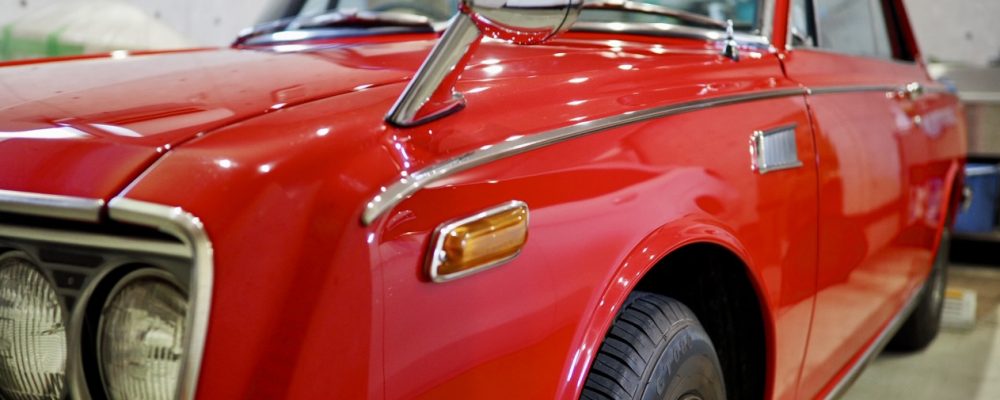
"If someone who will truly cherish it comes along, I would like to pass it on... The early model with serial #RT55-11568 is an exceptional specimen, showing only 19,782 km on the odometer, with the original Solar Red color beautifully restored...! This fully original model, which has been restored using rare, dead-stock parts, is in astonishing condition, having just passed a vehicle inspection...!"
The owner of this Toyota 1600GT, with whom I have been greatly indebted for a long time, is someone who carefully selects iconic cars from various eras, keeps them close, and spends years meticulously restoring them to their finest condition in collaboration with a dedicated mechanic. This process of restoration is the owner’s greatest pleasure.
I had the privilege of viewing this immaculate 1600GT5 several times in the garage before. The owner had expressed a desire to part with the car if the right buyer came along, and recently contacted me again saying, “I’ve just passed the ongoing vehicle inspection, so it’s time for you to come and cover it…” This led to the current feature. Despite the scorching heat of early August, I was able to conduct the interview in a cool, air-conditioned garage, equipped with a special circulator for the 1600GT. The owner’s thoughtful comment, “I wonder if the photos will turn out well in the garage,” made me feel their deep affection for the 1600GT, which they had so lovingly restored.
The owner came across this rare 1600GT about six years ago. The golden rule when it comes to finding an exceptional classic car is that they rarely appear when you’re actively searching—you have to wait for the right opportunity. The owner was originally searching for a Skyline 2000GTB, a car that held memories from their youth, when they stumbled upon this fully original 1600GT5, which had been meticulously stored in a friend’s garage. Right then and there, the owner decided to bring it home, marking the beginning of a new chapter with a car that vividly brought back memories of their youth.
When the 1600GT5 first arrived six years ago, it was in full original condition, with a sound engine and interior. However, it lacked a certain sparkle. That’s when the restoration process began.
Starting with a complete repaint in the original Solar Red color, the front and rear window moldings and side moldings that were removed for the paint job were polished to perfection. The owner also restored or replaced many parts, including the triangular window frames (with inner glass frame guides and lock buttons), outer and inner door handles, regulator handles, trunk emblem, front and rear bumpers, and the side window sashes, all of which were re-chromed to restore their original shine.
Additionally, through information exchange with members of the nationwide “1600GT Club,” the owner was able to acquire highly valuable parts. These included the brake booster and oil reservoir in the engine bay, side fender mirrors, cloisonné badges, front grille, rear number plate light, front fender air outlets, and even the extremely rare wheel caps. All these parts, original deadstock from the period, were used generously in the restoration.
The owner is also a member of the nationwide “1600GT Owners Club,” which facilitates the exchange of valuable parts and the reproduction of Toyota 1600GT-specific components that are no longer available from Toyota. The club has independently produced a wide range of parts, including chain tensioners, bushes, front and rear window seals, and rubber gaskets for the triangular windows. New owners will be introduced to the club and encouraged to join, ensuring continued access to these resources.
Over the past six years, the dedicated mechanic has addressed several issues:
- Difficulty engaging first gear:
-
- Overhauled clutch master cylinder (replaced inner kit, reservoir tank, and overhauled release cylinder; replaced operating kit).
- Replaced brake master cylinder using deadstock parts (complete with air bleeding and installation).
- Engine oil leakage near the drain filter cover:
-
- Fabricated and replaced the drain filter cover gasket; additionally tightened the oil pan to resolve the issue.
- Oil leakage from the rear of the engine crank seal:
-
- Tightened all parts of the transmission to stop oil leakage.
- Slightly faster brake fluid depletion after replacing the brake booster with a deadstock part:
-
- Inspected brake fluid leak, checked brake master cylinder, front calipers, and rear wheel cylinders. Found no issues, resolved the problem.
- Air intake noise from the carburetor:
-
- Tightened carburetor mounting bolts, adjusted carburetor balance, adjusted ignition timing, and replaced spark plugs.
- Unusual noise from the exhaust pipe:
-
- Tightened exhaust bracket bolts, removed and repaired the muffler with welding.
All these issues are documented in the repair details, which can be reviewed by potential buyers.
As a result of the owner’s six years of effort, the early 1967 model Toyota 1600GT5 with serial number RT55-11568 has been restored to a condition that anyone would describe as unparalleled. On the day of the interview, the engine started up smoothly, and the engine response to a few blips of the throttle was excellent. The dedicated mechanic suggested that the next step might be a carburetor overhaul, which could be done for around 40,000 to 50,000 yen.
Furthermore, the owner is someone who values maintaining the car in the best possible condition over the long term. They have even kept multiple spare deadstock parts for emergencies. The original parts removed during restoration, along with three boxes of deadstock parts, are also available for purchase at an additional price if desired. Please feel free to confirm the details during a visit to inspect the car.

1967 Toyota 1600 GT5 Post-Interview Report
The Toyota 1600 GT, which ceased production after just 1 year and 2 months, is a model that can be seen as the progenitor of Toyota’s subsequent coupe and hardtop series. This short production period makes sense when considering its role in laying the groundwork for future models. It is also likely that the enthusiasm for such an incredible car during that era provided many people with the energy to navigate the tumultuous times.
Having finally encountered such a remarkable vehicle, and having lavished it with affection, the owner feels it is unfair to keep it in the garage simply for the satisfaction of ownership while no longer being able to drive it. Prompted by the inevitable changes in life stages that everyone experiences, and with days increasingly spent merely admiring it in the garage, the owner has made the heart-wrenching decision to part with it.
In reality, the decision to part with the car is still in the process of being made, and it will be finalized when the next sincere owner comes along, someone for whom the owner can feel confident that they will continue to appreciate and care for this exceptional vehicle.
Turning Dreams into Reality! The Toyota 1600 GT5, a sibling to the Toyota 2000 GT that captured the hearts of young people at the time, has reappeared in pristine condition with just 19,782 km on the odometer, now in the hands of a collector! Using rare and expensive deadstock parts without hesitation, the early model RT55-11568 is in an astonishingly pristine state, fully original and restored, and has just passed its vehicle inspection, overwhelming onlookers with its impeccable condition!
This 1967 Toyota 1600 GT5, which has just passed its vehicle inspection in July of Reiwa 6 (2024), is an extremely rare and exceptional example. It is currently located in Saitama Prefecture.
As this is a private sale, there will be no consumption tax or other fees involved. However, the buyer will need to cover the prorated automobile tax (¥45,400 annually) and the recycling deposit (¥0, as it has not been deposited). Additionally, the buyer will be responsible for arranging transportation. If desired, I can assist with transportation through my company’s own classic car transport services. Please feel free to consult with me if you are interested.
Regarding Inquiries:
This vehicle is listed on the cross-border e-commerce site for classic and collectible cars, “Estate Sale Supremacy®.”
What is an Estate Sale Supremacy?
Estate Sale Supremacy® introduces vehicles imbued with the owner’s passion through interviews, written descriptions, and videos. It is a Japanese version of the North American estate sale culture, where the focus is on preserving and passing on the vehicle’s legacy rather than selling it for a mere pittance. We ensure that the owner’s heartfelt wishes are honored, with memories preserved and the vehicle effectively handed down to the next generation.
We conduct detailed interviews with the current owner, including checking past maintenance records, repair history, and accident history. We decline interviews if there are major accidents or if the current owner’s history is extremely short and details are unknown, ensuring that buyers receive as much reassurance as possible.
This 1967 Toyota 1600 GT5, which has just passed its vehicle inspection in July of Reiwa 6 (2024), is an extremely rare and exceptional example. It is currently located in Saitama Prefecture.
As this is a private sale, there will be no consumption tax or other fees involved. However, the buyer will need to cover the prorated automobile tax (¥45,400 annually) and the recycling deposit (¥0, as it has not been deposited). Additionally, the buyer will be responsible for arranging transportation. If desired, I can assist with transportation through my company’s own classic car transport services. Please feel free to consult with me if you are interested.
Regarding Inquiries:
This vehicle is listed on the cross-border e-commerce site for classic and collectible cars, “Estate Sale Supremacy®.”
What is an Estate Sale Supremacy?
Estate Sale Supremacy® introduces vehicles imbued with the owner’s passion through interviews, written descriptions, and videos. It is a Japanese version of the North American estate sale culture, where the focus is on preserving and passing on the vehicle’s legacy rather than selling it for a mere pittance. We ensure that the owner’s heartfelt wishes are honored, with memories preserved and the vehicle effectively handed down to the next generation.
We conduct detailed interviews with the current owner, including checking past maintenance records, repair history, and accident history. We decline interviews if there are major accidents or if the current owner’s history is extremely short and details are unknown, ensuring that buyers receive as much reassurance as possible.












